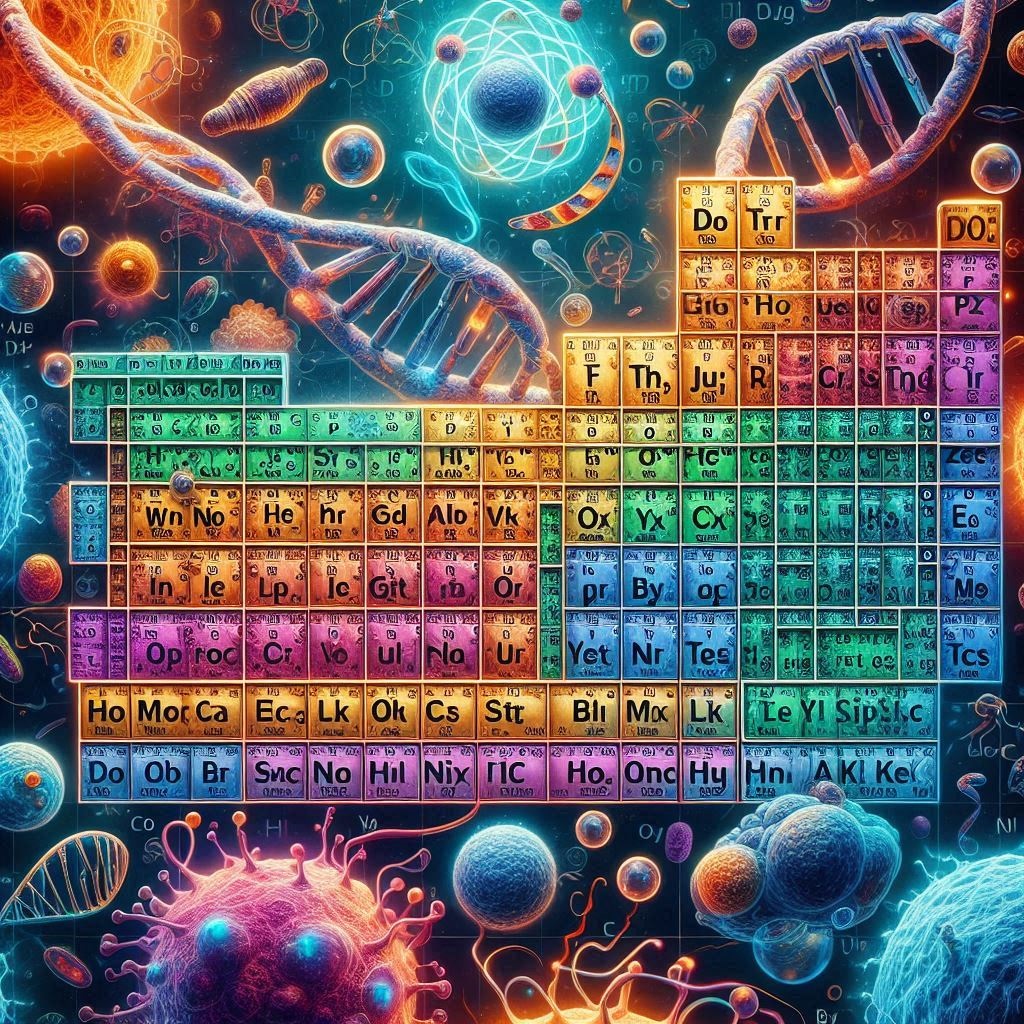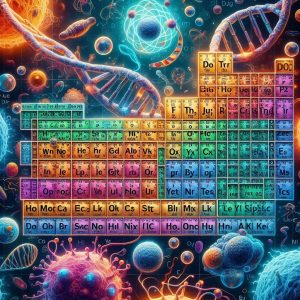The Chemical Elements of Life
The chemical elements of life are the fundamental building blocks that make up living organisms. These elements form the molecules and compounds essential for biological processes, including growth, energy production, and reproduction.
The Primary Elements
Approximately 99% of the mass of the human body is composed of six main elements: carbon, hydrogen, nitrogen, oxygen, phosphorus, and sulfur, often abbreviated as CHNOPS. These chemical elements of life are crucial for the formation of biomolecules such as proteins, nucleic acids, carbohydrates, and lipids.
| Element | Symbol | Function in Life |
|---|---|---|
| Carbon | C | Forms the backbone of organic molecules. Carbon atoms can bond with each other and with other elements, allowing for the formation of long chains and complex structures necessary for life. This versatility is the foundation of organic chemistry. |
| Hydrogen | H | Component of water and organic molecules. Hydrogen is the most abundant element in the universe and plays a key role in energy production through processes like cellular respiration and photosynthesis. It also helps to maintain the pH balance in organisms. |
| Nitrogen | N | Key component of amino acids and nucleotides. Nitrogen is essential for the formation of proteins and nucleic acids, which are vital for growth, repair, and genetic information storage. Nitrogen is cycled through the environment in the nitrogen cycle. |
| Oxygen | O | Essential for cellular respiration and water. Oxygen is critical for the production of ATP (adenosine triphosphate), the energy currency of cells. It is also a key component of water, which is indispensable for all known forms of life. |
| Phosphorus | P | Vital for energy transfer and nucleic acids. Phosphorus is a part of ATP and DNA molecules, playing a crucial role in energy storage and transfer, as well as in the storage and transmission of genetic information. |
| Sulfur | S | Important for protein structure. Sulfur is found in some amino acids (like cysteine and methionine) and vitamins, and is essential for the three-dimensional folding and stability of proteins. |
Trace Elements
In addition to the primary elements, trace elements are required in smaller amounts but are nonetheless essential for life. These include iron (Fe), which is crucial for oxygen transport in blood, and zinc (Zn), which plays a role in enzyme function. Understanding the chemical elements of life provides insight into the complex biochemical processes that sustain organisms.
The Role of Water
Water is often called the “universal solvent” and is vital for all known forms of life. It facilitates chemical reactions, helps regulate temperature, and acts as a medium for nutrient transport. The hydrogen and oxygen in water are themselves chemical elements of life and play crucial roles in biological systems.
The study of the chemical elements of life has significant applications in biochemistry and medicine. For example, understanding how these elements interact within the human body can lead to better treatments for diseases and the development of new medications. In biochemistry, researchers explore how these elements form the basis of complex molecules and biochemical pathways.
Emerging technologies, such as CRISPR-Cas9 for gene editing, rely on a deep understanding of the chemical elements of life. By manipulating these elements at the genetic level, scientists aim to correct genetic disorders, improve crop resilience, and advance personalized medicine.
Future Research Directions
Future research in the field of the chemical elements of life will likely focus on uncovering new elements that play critical roles in lesser-known biological processes. Additionally, advances in nanotechnology and molecular biology will enable more precise manipulation of these elements, opening new avenues for innovation in both healthcare and environmental science.
1. Nanotechnology and Precision Medicine
One promising area of future research is the integration of nanotechnology with the study of the chemical elements of life. By developing nanoscale materials and devices, scientists can target and manipulate specific cells and tissues with unprecedented precision. This approach has the potential to revolutionize personalized medicine, enabling treatments that are tailored to an individual’s unique biological makeup.
2. Synthetic Biology
Synthetic biology is another frontier that holds great promise. By engineering organisms at the genetic level, researchers aim to create new biological systems that can perform novel functions. This involves the manipulation of the chemical elements of life to design and construct new biological parts, devices, and systems. Applications include the production of biofuels, biodegradable materials, and therapeutic compounds.
3. Environmental Applications
Understanding the chemical elements of life is crucial for addressing environmental challenges. Research in this area can lead to the development of bioremediation techniques that use organisms to detoxify polluted environments. Additionally, insights into elemental cycles, such as the carbon and nitrogen cycles, can inform strategies to mitigate climate change and promote sustainability.
4. Astrobiology and the Search for Extraterrestrial Life
The study of the chemical elements of life also plays a critical role in astrobiology, the search for life beyond Earth. By understanding the elemental requirements for life, scientists can identify potential biosignatures on other planets and moons. This research enhances our understanding of the conditions that might support life in the universe.
5. Evolutionary Biology
Future research will continue to explore how the chemical elements of life have influenced the evolution of organisms. By examining the elemental composition of ancient life forms preserved in fossils, scientists can gain insights into the evolutionary processes that have shaped the diversity of life on Earth. This information can also help predict how organisms might evolve in response to changing environmental conditions.
Carbon: The Backbone of Life
Carbon is often referred to as the backbone of life due to its unparalleled ability to form stable bonds with other elements, including itself. This versatility allows for the formation of an immense variety of complex organic molecules. As a key component of all known life forms, carbon’s role is fundamental to the chemical elements of life.
| Property | Details |
|---|---|
| Atomic Number | 6 |
| Symbol | C |
| Atomic Mass | 12.011 |
| Key Compounds | CO₂ (Carbon Dioxide), CH₄ (Methane), C₆H₁₂O₆ (Glucose) |
Role in Biological Molecules
Carbon is a fundamental component of many biological molecules. It forms the backbone of organic molecules, which include carbohydrates, lipids, proteins, and nucleic acids. These macromolecules are crucial for the structure and function of cells, serving as energy sources, structural components, and carriers of genetic information.
Carbohydrates, such as glucose, are essential for energy storage and supply. Lipids, which include fats and oils, are important for long-term energy storage, insulation, and making up cell membranes. Proteins, composed of amino acids, are vital for numerous cellular functions, including enzyme catalysis, cell signaling, and structural support. Nucleic acids, such as DNA and RNA, store and transmit genetic information, guiding the development and functioning of living organisms.
Carbon Cycle
The carbon cycle describes the movement of carbon through the Earth’s biosphere, atmosphere, hydrosphere, and geosphere. This cycle is essential for regulating climate and maintaining the balance of carbon in different reservoirs. Photosynthesis and respiration are key processes in the carbon cycle, with plants absorbing carbon dioxide from the atmosphere and converting it into glucose through photosynthesis. Animals then consume these plants, using the glucose for energy and releasing carbon dioxide back into the atmosphere through respiration.
Applications and Importance
Understanding the role of carbon in the chemical elements of life has numerous applications in science and medicine. Carbon-based materials, such as carbon nanotubes and graphene, are being explored for use in advanced technologies, including electronics, energy storage, and medical devices. In medicine, carbon-based compounds are used in drug development and as biomarkers for disease diagnosis.
Environmental Impact
Carbon dioxide (CO₂), a major greenhouse gas, plays a significant role in climate change. Human activities, such as fossil fuel combustion and deforestation, have increased atmospheric CO₂ levels, leading to global warming and environmental degradation. Understanding the chemical elements of life, particularly carbon, is crucial for developing strategies to mitigate these impacts and promote sustainability.
Future Research Directions
Future research on carbon in the chemical elements of life is likely to focus on its role in novel materials, sustainable energy solutions, and environmental conservation. Advances in nanotechnology and materials science will continue to unlock new applications for carbon-based materials. Additionally, understanding the global carbon cycle and developing carbon capture technologies will be critical for addressing climate change and ensuring a sustainable future.
Hydrogen: The Essential Element
Hydrogen is the most abundant element in the universe and a vital component of the chemical elements of life. As a key element in water and organic compounds, hydrogen is indispensable for the biochemical processes that sustain life.
| Property | Details |
|---|---|
| Atomic Number | 1 |
| Symbol | H |
| Atomic Mass | 1.008 |
| Key Compounds | H₂O (Water), CH₄ (Methane), NH₃ (Ammonia) |
Role in Biological Molecules
Hydrogen plays a crucial role in the structure and function of biological molecules. It is a major component of water, which is essential for all known forms of life. Water serves as a solvent, temperature buffer, and reactant in many biochemical reactions. Hydrogen is also involved in the formation of organic molecules such as carbohydrates, lipids, proteins, and nucleic acids. These macromolecules are the building blocks of cells and are vital for energy storage, structural support, and genetic information transmission.
Hydrogen bonds, which occur between hydrogen atoms and electronegative atoms like oxygen or nitrogen, are critical for the stability and functionality of biological molecules. These bonds help maintain the three-dimensional structures of proteins and nucleic acids, enabling them to carry out their specific functions within the cell.
Hydrogen Cycle
The hydrogen cycle describes the movement of hydrogen through the Earth’s atmosphere, hydrosphere, and biosphere. This cycle is essential for maintaining the balance of hydrogen in different reservoirs. Processes such as evaporation, condensation, and precipitation are part of the hydrogen cycle, which is closely linked to the water cycle. Understanding the hydrogen cycle is crucial for studying climate patterns, water resources, and ecosystem dynamics.
Applications and Importance
Hydrogen has numerous applications in science and industry. It is used in the production of ammonia for fertilizers, refining petroleum, and as a fuel in hydrogen fuel cells. In the medical field, hydrogen is utilized in imaging techniques and as a potential therapeutic agent for various diseases. Understanding the role of hydrogen in the chemical elements of life is essential for advancing these technologies and applications.
Environmental Impact
Hydrogen plays a significant role in environmental processes and has potential as a clean energy source. Hydrogen fuel cells produce electricity through a chemical reaction between hydrogen and oxygen, emitting only water as a byproduct. This technology has the potential to reduce greenhouse gas emissions and dependency on fossil fuels, contributing to a more sustainable energy future. Additionally, understanding hydrogen’s role in environmental chemistry is important for addressing issues such as acid rain and atmospheric pollution.
Future Research Directions
Future research on hydrogen in the chemical elements of life is likely to focus on its applications in renewable energy, environmental sustainability, and medical therapies. Advances in hydrogen production, storage, and utilization technologies will be critical for developing clean energy solutions. Additionally, research into hydrogen’s role in biological systems and its potential therapeutic benefits will continue to expand our understanding of this essential element.
Nitrogen: The Building Block of Proteins
Nitrogen is another essential element for life. It is a major component of amino acids, which are the building blocks of proteins. Proteins are crucial for the structure and function of cells. Nitrogen is also a part of nucleic acids (DNA and RNA), which carry genetic information in living organisms.
| Property | Details |
|---|---|
| Atomic Number | 7 |
| Symbol | N |
| Atomic Mass | 14.007 |
| Key Compounds | N₂ (Nitrogen gas), NH₃ (Ammonia), NO₃⁻ (Nitrate) |
Role in Biological Molecules
Hydrogen and nitrogen are essential for the formation of biological molecules. Hydrogen is involved in energy production and the structure of organic molecules. Nitrogen is vital for the synthesis of proteins and nucleic acids. Both elements are crucial for the growth, repair, and functioning of living organisms.
Environmental Importance
Hydrogen and nitrogen cycles are important for maintaining the balance of these elements in the environment. The hydrogen cycle involves the movement of hydrogen through water and organic matter. The nitrogen cycle involves the transformation of nitrogen into different forms that can be used by plants and animals. These cycles are essential for sustaining life on Earth.
Applications and Future Research
Research on hydrogen and nitrogen continues to reveal new applications and insights. Hydrogen is being explored as a clean energy source in fuel cells. Nitrogen is essential in agriculture for plant growth. Future research will focus on sustainable ways to manage these elements and their impact on the environment.
Oxygen: The Vital Element
Oxygen is one of the most essential elements for life on Earth. It is crucial for the process of cellular respiration, which is how cells produce energy. Oxygen is also a key component of water (H₂O) and many organic molecules that make up living organisms.
| Property | Details |
|---|---|
| Atomic Number | 8 |
| Symbol | O |
| Atomic Mass | 16.00 |
| Key Compounds | O₂ (Oxygen gas), H₂O (Water), CO₂ (Carbon Dioxide) |
Role in Biological Molecules
Oxygen is a part of many biological molecules. It is found in carbohydrates, proteins, fats, and nucleic acids. These molecules are essential for the structure and function of cells. For example, oxygen is a key part of the structure of DNA, which carries genetic information in living organisms.
Oxygen Cycle
The oxygen cycle describes the movement of oxygen through the atmosphere, biosphere, and lithosphere. Plants produce oxygen through photosynthesis, which is then used by animals and other organisms during respiration. This cycle is crucial for maintaining the balance of oxygen in the environment.
Applications and Importance
Oxygen has many applications in medicine, industry, and environmental science. In medicine, oxygen therapy is used to treat patients with respiratory conditions. In industry, oxygen is used in steelmaking and chemical production. Understanding the role of oxygen in the chemical elements of life is essential for advancing these applications.

Environmental Impact
Oxygen plays a significant role in environmental processes. It is essential for the breakdown of organic matter and the formation of ozone, which protects the Earth from harmful ultraviolet radiation. Understanding oxygen’s role in environmental chemistry is important for addressing issues such as pollution and climate change.
Future Research Directions
Future research on oxygen in the chemical elements of life will likely focus on its role in renewable energy, environmental sustainability, and health sciences. Advances in oxygen-related technologies will be critical for developing sustainable solutions and improving human health.
Phosphorus: The Essential Element
Phosphorus is a crucial element for life, playing a key role in the formation of DNA, RNA, and ATP, which are essential molecules in all living organisms. It is involved in energy transfer, genetic information storage, and cellular communication.
| Property | Details |
|---|---|
| Atomic Number | 15 |
| Symbol | P |
| Atomic Mass | 30.97 |
| Key Compounds | H₃PO₄ (Phosphoric acid), Ca₃(PO₄)₂ (Calcium phosphate), ATP (Adenosine triphosphate) |
Role in Biological Molecules
Phosphorus is a component of nucleic acids, which make up DNA and RNA. These molecules are essential for storing and transmitting genetic information. Phosphorus is also a part of ATP, which is used by cells to transfer energy for various biological processes.
Phosphorus Cycle
The phosphorus cycle describes the movement of phosphorus through the environment, from rocks and soil to living organisms and back. Unlike other biogeochemical cycles, the phosphorus cycle does not involve the atmosphere. Phosphorus is released from rocks through weathering and is taken up by plants from the soil. Animals obtain phosphorus by consuming plants or other animals. When organisms die, phosphorus is returned to the soil.
Applications and Importance
Phosphorus is widely used in agriculture as a fertilizer to enhance plant growth. It is also important in medicine and food production. Understanding the role of phosphorus in the chemical elements of life helps in developing sustainable agricultural practices and improving food security.
Environmental Impact
Phosphorus runoff from agricultural fields can lead to water pollution, causing algal blooms that deplete oxygen in water bodies, affecting aquatic life. Managing phosphorus use and recycling is crucial for maintaining environmental balance and preventing ecosystem damage.
Future Research Directions
Future research on phosphorus in the chemical elements of life will focus on sustainable agriculture, environmental protection, and medical applications. Innovations in phosphorus recycling and efficient use will be vital for addressing global challenges related to food security and environmental health.
Sulfur: The Versatile Element
Sulfur is an important element for life, known for its role in proteins and vitamins. It is found in amino acids, which are the building blocks of proteins, and in vitamins such as biotin and thiamine, which are essential for various metabolic processes.
| Property | Details |
|---|---|
| Atomic Number | 16 |
| Symbol | S |
| Atomic Mass | 32.06 |
| Key Compounds | H₂S (Hydrogen sulfide), SO₄²⁻ (Sulfate), CH₃-S-CH₃ (Dimethyl sulfide) |
Role in Biological Molecules
Sulfur is a component of two essential amino acids, cysteine and methionine, which are critical for the structure and function of proteins. These amino acids form disulfide bonds that help maintain protein structure. Sulfur is also part of coenzymes and vitamins that play vital roles in metabolism.
Sulfur Cycle
The sulfur cycle describes the movement of sulfur through the environment, from the earth’s crust to the atmosphere and living organisms. Sulfur is released from rocks through weathering and volcanic activity. Plants absorb sulfur from the soil, and animals obtain sulfur by eating plants or other animals. Decomposers return sulfur to the soil, completing the cycle.
Applications and Importance
Sulfur is used in various industrial processes, including the production of sulfuric acid, which is important in manufacturing fertilizers, chemicals, and batteries. Understanding the role of sulfur in the chemical elements of life helps improve these applications and manage sulfur’s environmental impact.
Environmental Impact
Sulfur emissions from industrial activities can lead to air pollution and acid rain, which harm ecosystems and human health. Managing sulfur emissions and understanding its environmental chemistry is crucial for minimizing these negative impacts.
Future Research Directions
Future research on sulfur in the chemical elements of life will focus on sustainable industrial practices, environmental protection, and the role of sulfur in human health. Advances in these areas will be essential for developing new technologies and improving environmental quality.
FAQs About The Chemical Elements of Life
What are the primary chemical elements of life?
The primary chemical elements of life are carbon (C), hydrogen (H), nitrogen (N), oxygen (O), phosphorus (P), and sulfur (S). These elements are essential for the formation of biomolecules such as carbohydrates, lipids, proteins, and nucleic acids.
Why are these elements important for life?
These elements are crucial because they form the backbone of organic molecules that constitute living organisms. For example, carbon forms the basic structure of organic compounds, hydrogen and oxygen are components of water, and nitrogen is essential for amino acids and nucleic acids.
How do these elements contribute to biological processes?
Each element plays a specific role in biological processes. Carbon is the primary element in organic compounds, hydrogen is involved in energy transfer, nitrogen is key for protein synthesis, oxygen is essential for cellular respiration, phosphorus is part of ATP, and sulfur is found in some amino acids.
What are some examples of biomolecules containing these elements?
Examples of biomolecules include carbohydrates (glucose), lipids (triglycerides), proteins (enzymes), and nucleic acids (DNA and RNA). Each of these molecules contains varying combinations of the primary elements of life.
How are these elements obtained by living organisms?
Living organisms obtain these elements through their diet and environment. Plants absorb elements from the soil and atmosphere, while animals obtain them by consuming plants or other animals. These elements are then utilized in various metabolic processes.
Disclaimer
The information provided in this FAQ section is for educational purposes only. While efforts have been made to ensure the accuracy of the content, it should not be used as a substitute for professional advice or scientific research. Readers are encouraged to consult authoritative sources and experts in the field for more detailed information.I mentioned again this the information provided in this article is for educational purposes only and is not intended as a substitute for professional advice or scientific research.
Caution
When studying or working with chemical elements, it is important to follow safety protocols and ethical guidelines. Chemical research should be conducted responsibly, with consideration for environmental and human health. Always seek guidance from experienced professionals and adhere to local regulations and international standards.






